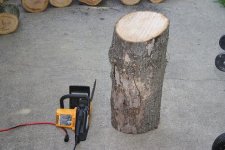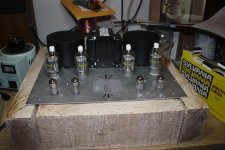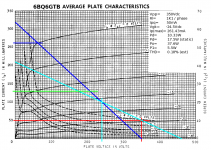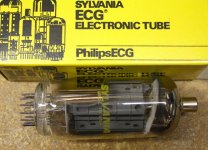I discovered by chance that a 6FW5 tube will fit the 8-pin sockets
Can you get 6FW5's in your corner of the world? They aren't exactly common here. The 6FW5 is a 17 watt rated 6AV5. The 6FW5, the 6AV5 and the 6AU5 (too small for this amp) are the only tubes with the same pinout. For some information related to 6AV5's and 6FW5's see this thread:
http://www.diyaudio.com/forums/tubes-valves/160783-6av5ga-amp.html?highlight=6av5+6fw5+6bq6
I see no reason why the 6FW5 and the hefty versions of the 6AV5GA and even the larger 6BQ6GA's won't work in this amp. In fact I have run at least a dozen different output tubes in this amp and other than some bias adjustments, they all worked just fine.
Does anyone know of an equivalent 9-pin tube to replace the 7-pin 6CB6 sharp cut-off pentode
Again I have stuffed a bunch of different input tubes into this amp and they all worked. In fact the tubes that are in the amp now aren't even pentodes, they are hexodes (6GU5). The 6CB6 is an IF amplifier from a TV set. If I were looking for a 9 pin tube, I would start with IF amps, and see what you can get locally. My first guess would be the 6EJ7.
Pete's design should work very well with audio tubes at the output. So unless you have some sweep tubes on hand or can get a large stock for cheap, I'm not sure it makes much sense to make a 20WPC amp using sweep tubes. The input section is something worth trying to duplicate, but I imagine any small pentode will work reasonably well there...even EF86 if you want to stick with something that is in production.
Time to make the chassis, the hard way! Nothing like some red oak for the chassis. I caved and got a ready to go top plate. Otherwise this would probably sit on the shelf for a long time.
The wood is going to need a lot more work to get it to fit nice but you get the idea.
Smoke test soon.
The wood is going to need a lot more work to get it to fit nice but you get the idea.
Smoke test soon.
Attachments
I don't think you could take a sweep tube and get the same amount of linearity using UL than you can with plate-to-grid feedback. Sweep tubes were never intended for audio. Of course, I have no data to back my statement up...just my understanding of it.
It really doesn't matter that sweep tubes were never intended for audio. They were intended to give excellent scan linearity and to source bigamps at low Vpk's -- just what you need to push currents through the deflection coils. Given that, the horizontal deflection PAs make some mighty fine audio finals.
Here's a loadline I did for my last project. That's almost forty watts out with sonic quality that beats many an audio final, and that's running open loop with no gNFB applied at all. Open loop, 6BQ6s have much less pentode nastiness than a good many audio finals. Indeed, these are every bit as good as the famous 6V6s, and you can get over twice the power. I didn't need to include local NFB (either UL or parallel NFB from plate to grid).
Definitely don't overlook "not designed for audio" VTs. You can find some excellent performers available at considerably less than audiophool prices.
Attachments
The wood is going to need a lot more work to get it to fit nice but you get the idea.
Smoke test soon.
Looks like you've already created some smoke with that poor little electric chain saw.😉
Those Antek OPT's?
Jeff
The saw has plenty of power, but the safety chain doesn't cut worth anything. I had to swap out the 18" bar because it was all bent up. So I used a smaller 14" that did much better.
Yeah those are Antek 35w output transformers. I figure since I can adjust the bias for each tube I should be able to minimize dc imbalance. Nobody seems to have anything to say about them so I figured I'd try 'em and report back my experience.
I tried a smoke test this morning and the spirits tried to escape from R21. With the variac set to about 80vac I was reading 7v on the high B+. Not good. Must be a short somewhere on the screen regulator. Or more. That's what I get for goofing with the BOM. I'll need to double check the power transformer wiring to be sure I got it right for the Hammond 370HX.
Yeah those are Antek 35w output transformers. I figure since I can adjust the bias for each tube I should be able to minimize dc imbalance. Nobody seems to have anything to say about them so I figured I'd try 'em and report back my experience.
I tried a smoke test this morning and the spirits tried to escape from R21. With the variac set to about 80vac I was reading 7v on the high B+. Not good. Must be a short somewhere on the screen regulator. Or more. That's what I get for goofing with the BOM. I'll need to double check the power transformer wiring to be sure I got it right for the Hammond 370HX.
So after drinking a cup of coffee I sat down and checked out everything on the board. I'm apparently suffering from brain damage because I did some pretty silly things. Four capacitors had reversed polarity. Good thing for the variac or they probably would have identified themselves in a spectacular manner. I didn't trust any of them after I pulled them out so I swapped them for new caps. I didn't have a 10uF for filter so it got a 4.7uF which should be sufficient. I had also swapped the NFB and inputs. That totally didn't go well at all. I thinks one of my 6CB6's was a dud too. Doesn't help that I dropped a good one and put a small chip in one of them.
Nuts!
So it works now. I figure I'll use a signal generator and super human hearing to make adjustments until I can get my oscilloscope working. 🙂
Nuts!
So it works now. I figure I'll use a signal generator and super human hearing to make adjustments until I can get my oscilloscope working. 🙂
I had a bit of a curse with this amp for a little while too. Was really not the amp's fault. Funnier was when I first powered-up Pete's sound card interface. It made a whining noise and the 15V rails did not come up. Turned out I plugged both INA134s in backwards. They were hot and very unhappy. It was probably late at night, but still...it's a simple matter to check my work before applying power...but it's low voltage, right?
Kudos for catching the mistakes early. Those variacs pay for themselves quickly.
Kudos for catching the mistakes early. Those variacs pay for themselves quickly.
.....snip...
So it works now. I figure I'll use a signal generator and super human hearing to make adjustments until I can get my oscilloscope working. 🙂
Hey Rat...
Play some music 😱 through that thing. Ya don't need no 'scope. And some John Coltrane is better than any old signal gen.
You'll find the tubes settle down nicely around 10 hours after the first adjustments. The tiny trimmer pots are hair-trigger sensitive, but I had fun playing with them and watching the DVM's go nuts!
I love the music the red board makes. I hope you do too.
Ironically the first tunes to run though the amp was Coltrane.
Hats off the Mr Millett. A fine amplifier. Dead quiet and it sure delivers the goods. The jury is still out on the Antek AT-0358's (my Tannoy's need tweaking). That's for a different thread.
Hats off the Mr Millett. A fine amplifier. Dead quiet and it sure delivers the goods. The jury is still out on the Antek AT-0358's (my Tannoy's need tweaking). That's for a different thread.
Ironically the first tunes to run though the amp was Coltrane.
No, that would be coincidence, no irony in sight. Sorry, not at all relevant, just one of those things that gets me going.
no irony in sight.
Mea culpa. Thanks for calling me out on that!
I don't know if this thread is exhausted, but I have a question. I am whipping up one of these DCPP amps using bits and pieces I have on hand. This will be my first foray outside of Class A, but I do have a Gary Pimm style 47 amp to my credit (Class A).
I was thinking of getting my negative power supply by having some hefty resistance between the center tap of the power transformer and ground (its a 350-0-350 so it will have some excess volts as compared to Pete Millett's schematic), with C- coming off of the negative side of that resistance. Were talking about a full-wave center tapped power supply. It just dawned on me that, when running the amp hard, I may get some voltage sag that would be kind of disruptive to my fixed bias.
Is it a no no in a Class AB push pull amp to try what I am proposing?
I was thinking of getting my negative power supply by having some hefty resistance between the center tap of the power transformer and ground (its a 350-0-350 so it will have some excess volts as compared to Pete Millett's schematic), with C- coming off of the negative side of that resistance. Were talking about a full-wave center tapped power supply. It just dawned on me that, when running the amp hard, I may get some voltage sag that would be kind of disruptive to my fixed bias.
Is it a no no in a Class AB push pull amp to try what I am proposing?
It just dawned on me that, when running the amp hard, I may get some voltage sag that would be kind of disruptive to my fixed bias......Is it a no no in a Class AB push pull amp to try what I am proposing?
The current through a single output tube can vary from 40 mA at idle to over 100 mA at ful tilt. In some of my implementations it ranged from 40 me to 300 mA. This makes deriving bias via a resistor not a good idea. A really big zener diode or zener emulator might work. See the end of SY's RLD thread for circuits.
BTW 350-0-350 is a small transformer for this amp by my standards. rknize is using a 400-0-400 which is probably what I will use if I settle for a 100 WPC version. I have seen 200 WPC but that will require a bigger transformer. A 350-0-350 will probably work with 450 volt caps, but anything bigger needs 500 volt or higher parts.
I got 45 NOS Sylvania 35LR6's at the Dayton hamfest for $3 each. I plan to try them in this amp after hacking up the heater circuit a bit. I am beginning to doubt the quality of Sylvania tubes produced near the end of the vacuum tube era. Many readers will recall the fact that I bought 100 NOS Sylvania 6V6GT's in bulk pack at a military surplus auction. About 1/3 of the tubes had white getters due to vacuum leakage. They have been in an air conditioned house for the past 10 years, and many more have slowly gone to air. So whats next? Check out the photo of the 35LR6 that I pulled out of an unopened box. It looks like some assembler just tossed the parts into the glass envelope. Clearly this wasn't tested.
Attachments
I am beginning to doubt the quality of Sylvania tubes produced near the end of the vacuum tube era. It looks like some assembler just tossed the parts into the glass envelope. Clearly this wasn't tested.
Yep George, i've seen the same on ECG-Philips 6080WC for the Mil ... all of them must see a pre-ageing before use in my OTLs : just to cook the residual metallic dust . If not , they flash ... 😕
I have Philips/ECG 35LR6s as well, though mine look better than that. I guess some assemblers were operating with a load on, so to speak...
Any scratch marks on the getter? I'm betting it was dropped at some point. Obviously there was an assembly issue if the mica pops out so easily. At least you got them for cheap. 🙂
Any scratch marks on the getter? I'm betting it was dropped at some point.
There were 45 6LR6's and a bunch of other tubes (all Sylvania) in a tube caddy. This tube shows no obvious signs of physical damage, and the other ones that I checked look OK. The real test will be when they get plugged into the red board and meet the big HP power supply. I have recapped my red board to allow turning the knob as far as it will go! It's safe to assume that something will go boom!
George what cap voltages are you using. I have been trying to find some in higher voltages but it seems that 450volts is the max that is readily available. Currently I have a stock of panasonics but if I could find some higher voltage caps I may opt to use them instead.
Last edited:
I found four 4200uF 250V(300V Surge) caps in the lab. I could stack two to get 500V, but that would be like setting a hand grenade on my bench.
Antique Electronic Supply has 500V and 525V multisection cans.
Digi Key has 500V ones. Mouser has 500V ones.
Motor Run caps go up to 660V.
Smaller capacitance values for filtering at Mouser go up to 600V. 10uF 600V - $23.85!! 😱
Antique Electronic Supply has 500V and 525V multisection cans.
Digi Key has 500V ones. Mouser has 500V ones.
Motor Run caps go up to 660V.
Smaller capacitance values for filtering at Mouser go up to 600V. 10uF 600V - $23.85!! 😱
- Home
- Amplifiers
- Tubes / Valves
- Posted new P-P power amp design




